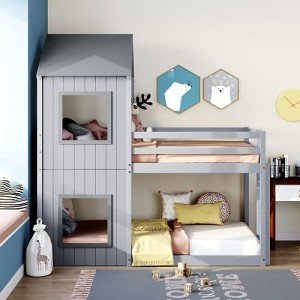5 Reasons To Be An Online Bunk Beds Sale Buyer And 5 Reasons Not To
Bunk Beds Sale: A Comprehensive Guide to Choosing the Right Bunk Bed for Your Home
Bunk beds have long been a staple in kids's bed rooms, offering a mix of space-saving effectiveness and fun. Whether accommodating siblings, good friends on pajama parties, or merely taking full advantage of a playroom, bunk beds have ended up being an important component in modern household homes. As sales on bunk beds rise, it ends up being increasingly essential for customers to make educated choices when purchasing one. This short article will cover the fundamentals of acquiring a bunk bed, from types to safety features, in addition to suggestions for keeping the integrity of your investment.
Kinds Of Bunk Beds
When considering a bunk bed sale, it's essential to comprehend the different styles readily available on the market. Below are the most common types:
Traditional Bunk Beds: These consist of 2 beds stacked one above the other, sharing a single frame. They are frequently the most economical choice.
L-Shaped Bunk Beds: This design includes one bed positioned vertically and another horizontally. This plan creates extra space beneath the upper bed, which can be used for storage or a backyard.
Lofted Beds: Similar to traditional bunk beds however without any lower bed. Rather, the space beneath can be utilized for a desk, play location, or additional storage.
Triple Bunk Beds: For households with a larger number of children or regular sleepovers, triple bunk beds provide three sleeping areas in a space-efficient design.
Futon Bunk Beds: These designs merge bunk beds and futon sofas. The bottom section converts into a different seating location, boosting functionality.
Convertible Bunk Beds: These beds can be separated into 2 individual beds, making them flexible as children's needs change in time.
Table 1: Comparison of Bunk Bed Types
Type
Description
Space Efficiency
Extra Features
Traditional Bunk Bed
2 beds stacked vertically
High
Simplest design
L-Shaped Bunk Bed
One vertical and one horizontal bed
Moderate
Play or storage space
Lofted Bed
Elevated bed with open space below
High
Work/play location
Triple Bunk Bed
3 stacked beds
Extremely High
Accommodates more users
Futon Bunk Bed
Bunk bed with a convertible futon
High
Multi-functional
Convertible Bunk Bed
Can be split into two separate beds
Moderate
Versatility & & durability
Safety Features to Consider
Safety is critical when buying a bunk bed. Below are key security features to try to find:
Guardrails: Adequate guardrails must exist on both sides of the upper bunk to prevent falls. They ought to be at least 5 inches higher than the mattress.
Ladder Design: Look for durable, large ladders with slip-resistant rungs. Guarantee that the angle is not too steep for simple gain access to.
Stability: Ensure the bed is built with strong materials, such as strong wood or durable metal. The bed should not wobble when in use.
Weight Limit: Check the weight capacity of the bunk bed to ensure it can accommodate the intended users safely.
Product Safety: If possible, choose beds made from non-toxic materials or those fulfilling security requirements for children's furnishings.
Table 2: Essential Safety Features
Feature
Description
Value
Guardrails
Sides of upper bed to avoid falls
Essential for kid safety
Ladder Design
Strong, slip-resistant rungs
Aids safe and simple access
Stability
Construct quality to avoid wobbling
Ensures safety and longevity
Weight Limit
Optimum weight capability
Avoids mishaps
Material Safety
Non-toxic, safe materials
Secures kids's health
Maintenance Tips for Bunk Beds
To extend the life of your bunk bed and guarantee ongoing security, think about the following maintenance tips:
Regular Inspections: Periodically inspect the structure for loose screws, bolts, or any indications of wear. Tighten fasteners as required.
Tidy Periodically: Dust and clean the surfaces frequently. Usage appropriate cleaners that won't damage the surface.
Check Weight Limits: Be conscious of weight limits, particularly with older kids or adults who might want to use the upper bunk.
Avoid Climbing on Guardrails: Educate kids not to use guardrails for climbing or playing to reduce the risk of accidents.
Often Asked Questions (FAQs)
Q1: What is the age limit for kids to safely use bunk beds?A: While it differs by the producer, lots of suggest that children under six need to not sleep in the upper bunk due to security issues.
Q2: How can parents dissuade unsafe climbing?A: Setting clear guidelines about bunk bed usage and monitoring kids can help. Additionally, using Bunks teresehassan.top can dissuade climbing while creating an enjoyable sleep environment.
Q3: What should I think about when embellishing a room with bunk beds?A: Ensure there is enough space around the bunk bed for safe motion, and utilize the decor to produce customized areas for each kid.
Q4: Is a lofted bed appropriate for older kids?A: Yes, lofted beds can be appropriate for older children as long as they fulfill safety requirements and the kid is responsible enough to use them safely.
Bunk beds serve a practical function while including a component of fun to a kid's bed room. As sales of bunk beds continue to rise, cautious factor to consider of types, safety functions, and upkeep practices is essential for parents and caregivers. By understanding these essential aspects, families can discover the best bunk bed for their home, ensuring both usefulness and security for years to come. Whether it's for siblings sharing a space or developing a cozy sleepover space, a well-chosen bunk bed can provide joy and functionality, making it a deserving financial investment.
